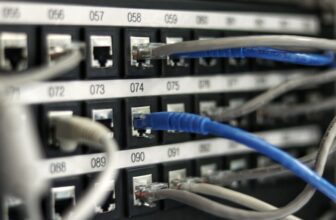
When transmitting high-speed networking signals, cables are crucial in communicating information accurately and without loss. DAC (Direct Attach Cable) and AOC (Active Optical Cable) cables are commonly used. While they may seem similar, some significant differences are worth understanding.
This post will explore the differences between DAC vs AOC cables, their advantages and disadvantages, and help you choose the suitable cable for your needs.
Now, let’s dive in.
What is DAC?
A Direct Attach Copper Cable (DAC) assembly connects two network devices. It transmits high-speed data through two small form-factor pluggable connectors, such as SFP+/QSFP/QSFP28. Although some IT professionals refer to it as a transceiver, it is not an optical transceiver in a strict sense.

DAC cables are commonly used in data centers and other high-performance computing environments where short-distance, high-speed connections are necessary. They are cost-effective and easy to use, making them popular for connecting servers, switches, and storage devices.
What is AOC?
AOC is a high-speed Active Optical Cable that transmits digital signals over longer distances than traditional copper cables. They are immune to electromagnetic interference, making them ideal for use in environments with a lot of electrical noise. Additionally, AOCs are generally lighter and thinner than DAC copper cables, making them easier to install and manage.

Several popular types of AOC cables exist, including QSFP, SFP+, QSFP28, and HDMI. The QSFP (Quad Small Form-factor Pluggable) and SFP+ (Small Form-factor Pluggable) AOCs are suitable for connecting servers, switches, and storage devices in data centers. Meanwhile, QSFP28 AOC cables are designed for even higher speeds and increased bandwidth.
Unlike the above AOC, HDMI (High-Definition Multimedia Interface) AOCs transmit high-definition video and audio signals over longer distances than traditional HDMI cables.
DAC vs AOC Cable: What is the difference?
1. Max Distance
DAC cables are generally limited to shorter distances, with maximum lengths typically around 15 meters. In contrast, AOC cables can transmit data over much longer distances, with some models capable of reaching up to 100 meters or more. That makes AOC cables a better choice for applications requiring longer distances.
2. Cost
DAC cables are typically less expensive than AOC cables, making them a more cost-effective option for short-distance connections. AOC cables can be more costly due to their use of optical fibers and other advanced technologies. However, the price difference between the two types of cables can vary depending on cable length, data transfer speeds, and connector types.
3. EMI Immunity
Regarding EMI (Electromagnetic Interference) immunity, AOC cables have a significant advantage over DAC cables. That is because AOC cables use optical fibers to transmit digital signals, which are not affected by electromagnetic interference. On the other hand, DAC cables use copper wires, which are susceptible to EMI. That makes AOC cables ideal for use in environments with much electrical noise. In contrast, DAC cables are better suited for short-distance connections in low-noise environments.
4. Power Consumption
Regarding power consumption, DAC cables are generally more power-efficient than AOC cables. That is because AOC cables require additional power to convert the electrical signals to optical signals. On the other hand, DAC cables use copper wires to transmit electrical signals, which require less power. That makes DAC cables a better choice for low-power applications. In contrast, AOC cables are more suitable for high-performance computing environments where power consumption is not a significant concern.
5. Latency
Regarding latency, both DAC and AOC cables have similar performance. However, DAC cables may have a slightly higher latency due to the copper cable media. This difference in latency is generally minimal and may not be noticeable in most applications.
How to choose?
When choosing between DAC vs AOC cables, consider cost, power consumption, and latency factors. DAC cables are typically less expensive and more power-efficient than AOC cables, making them the perfect choice for low-power applications. They are ideal for connecting servers, switches, and storage devices within or adjacent to the rack.
However, AOC cables are more suitable for requiring higher-performance computing environments due to their higher bandwidth and longer transmission distances. That makes them ideal for use in larger data centers with a lot of electrical noise, such as ToR (Top of Rack), EoR (End of Row), and MOR (Middle of Row) applications.
Ultimately, choose a cable that meets your specific needs and provides the highest level of performance for your application.
DAC vs AOC Cable FAQs
Q: Can DAC and AOC replace each other?
A: DAC and AOC cables are not typically interchangeable, but there are some cases where one can be used instead of the other. For example, an AOC cable may be used instead if a short-distance connection requires higher bandwidth than a DAC cable. However, it’s essential to consider factors such as data transfer speed, cost, power consumption, and latency. It’s best to consult a professional to determine the most appropriate cable.
Conclusion
In conclusion, while DAC and AOC cables may seem similar, significant differences are worth understanding. The choice between the two cables ultimately depends on the user’s needs, including distance, cost, power consumption, and environment. By considering these factors, users can decide which cable is the most suitable for their application.
Reference




